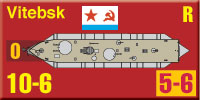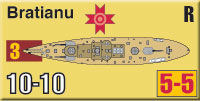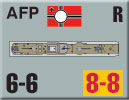| River Battleships:
Scenario Preview, Part Three
by Mike Bennighof, Ph.D.
October 2021
 Naval wargames – the ones with battleships and other ships – are immensely popular. They’ve been around for close to 60 years in their modern form, and there have been hundreds of them published, only about half of those by Avalanche Press. Naval wargames – the ones with battleships and other ships – are immensely popular. They’ve been around for close to 60 years in their modern form, and there have been hundreds of them published, only about half of those by Avalanche Press.
But there has never been, as far as I know, a game about river monitors. Maybe about Civil War river gunboats, or Vietnam War river gunboats, but never about the armored river boats (a vessel on a river is always a boat, no matter what its size) of World War II. Part of that’s probably a language thing – not many wargame designers read Romanian or Russian, and most river monitors were Romanian or Soviet (with the Poles having a fleet of small monitors, too). And then there’s the ugly part of wargaming’s history – if the Germans had built a fleet of cool-looking river warships and given them suitably Teutonic names . . .
So Panzer Grenadier: River Battleships is a unique game, with a unique topic. The river fleets of World War II actually existed, even if they’ve been ignored by wargames (and most histories, too). And in River Battleships, they get to fight each other. Let’s have a look at another chapter of the game’s scenarios.
Chapter Three
The River Dnepr
Scenario Nine
Upper Dnepr
June 1941
 The former Polish monitors of the “Zhytomyr” type had been salvaged in 1940 andre-armed with Soviet weapons. They formed the core of the Pinsk Flotilla, which also patrolled the upper Dnepr. The Germans did not yet field their improved river gunboats on Russian rivers – dive-bombers proved sufficient – but had their inland fleet been a part of Operation Barbarossa, the Pinsk Flotilla would have stood in their way. The former Polish monitors of the “Zhytomyr” type had been salvaged in 1940 andre-armed with Soviet weapons. They formed the core of the Pinsk Flotilla, which also patrolled the upper Dnepr. The Germans did not yet field their improved river gunboats on Russian rivers – dive-bombers proved sufficient – but had their inland fleet been a part of Operation Barbarossa, the Pinsk Flotilla would have stood in their way.
Conclusion
The small ex-Polish monitors did not have the staying power of the bigger Soviet or Romanian river craft, but the German “artillery lighters” were essentially motorized barges with a pair of 88mm guns stuck on them. Most rivers in the Soviet Union flowed from north to south, which made them less than useful for an invading enemy, but well-placed to shuttle supplies and reinforcements behind the defender’s front.
Notes
The Germans are motoring about on oversized pontoon boats with guns stuck on them, against a flock of small river monitors that don’t have the armor to keep out 88mm shells but at least are actual warships. The Germans have to smash their way past the Soviets, while shepherding along some unarmed river steamers, so there’s going to be some close-range action – and all of this happening at night.
Scenario Ten
Lower Dnepr
July 1941
 While Austro-Hungarian river monitors had journeyed across the Black Sea to patrol Ukrainian rivers, the Romanian flotilla did not repeat the feat and remained in local waters throughout the war. Had they done so, they would have found a strong Soviet flotilla determined to block the big river and make it a defensive bulwark against the oncoming Axis blitzkrieg. While Austro-Hungarian river monitors had journeyed across the Black Sea to patrol Ukrainian rivers, the Romanian flotilla did not repeat the feat and remained in local waters throughout the war. Had they done so, they would have found a strong Soviet flotilla determined to block the big river and make it a defensive bulwark against the oncoming Axis blitzkrieg.
Conclusion
Under the threat of German air attack, the Soviet monitors could only move easily at night – the monitor Zhelezhnyakov alone fended off 127 air strikes during the course of the Great Patriotic War. Those that could not enter the Black Sea and escape to the east (like Zhelezhnyakov) would be destroyed by air attacks or blown up by their own crews. The Romanian flotilla’s task would have been to prevent such an escape.
Notes
The Romanians are back, for a large-scale, close-range nighttime brawl in the Dnepr estuary – all of the scenarios in this chapter take place at night, as river warships were prime targets for enemy aircraft by day. The Romanian monitors are better protected than their enemies, which will help them, since they’re outnumbered by the Soviets.
Scenario Eleven
Crossing Over
August 1941
 The broad Dnepr River presented a serious barrier to the Axis advance, and without a river flotilla of their own the Germans and Romanians were forced to build extremely long pontoon bridges to get their forces across. That might have been easier with some river craft and monitors to protect them, but the Soviets would still have a say in the matter. The broad Dnepr River presented a serious barrier to the Axis advance, and without a river flotilla of their own the Germans and Romanians were forced to build extremely long pontoon bridges to get their forces across. That might have been easier with some river craft and monitors to protect them, but the Soviets would still have a say in the matter.
Conclusion
Ferrying troops across rivers was a primary task for the inland flotillas – the Soviet Volga Flotilla made the defense of Stalingrad possible by assuring a constant stream of reinforcements as well as ready fire support. Both the Germans and Romanians eventually threw pontoon bridges over the big river; the German-Romanian bridge constructed at Berislav in early September was the longest such structure ever built while under enemy fire.
Notes
The Romanians are on the river, with some steamers bringing their troops across and the monitors standing by to protect them from enemy river craft. Those show up right away, trying to sink the unarmed steamers and keep the Romanians on their own side of the river. All of the Soviets are “river tanks,” the small armored gunboats carrying a tank turret.
Scenario Twelve
Light Craft
August 1941
 Having built no true river monitors of their own, the Germans compensated with their armed motorized barges, called artillery lighters. The Soviets, for their part, built huge numbers of small gunboats known as armored cutters, equipped with one or two tank turrets. Over 200 of them were built, and these formed the backbone of the Soviet river flotillas. Having built no true river monitors of their own, the Germans compensated with their armed motorized barges, called artillery lighters. The Soviets, for their part, built huge numbers of small gunboats known as armored cutters, equipped with one or two tank turrets. Over 200 of them were built, and these formed the backbone of the Soviet river flotillas.
Conclusion
The German motorized barges carried a heavy armament – a mix of modern anti-aircraft guns and older naval guns removed from decommissioned warships of the Great War era – but lacked any protection apart from splinter shields for their gun crews. The Soviet river-going tanks held a great advantage over them, which is probably why the Germans did their utmost to keep the two types of river warcraft from meeting.
Notes
Motorized barges and river tanks fighting it out in the dark of night. Neither one of those is a “river monitor,” but they represented most of the riverine fighting strength of the two major participants on the Eastern Front. The German swamp boats are frail, but those 88mm guns give them considerably striking power.
And those are the scenarios from Chapter Three. Next time, it’s Chapter Four and Five (together!).
You can order River Battleships right here.
Sign up for our newsletter right here. Your info will never be sold or transferred; we'll just use it to update you on new games and new offers.
Mike Bennighof is president of Avalanche Press and holds a doctorate in history from Emory University. A Fulbright Scholar and NASA Journalist in Space finalist, he has published an unknowable number of books, games and articles on historical subjects.
He lives in Birmingham, Alabama with his wife, three children and his dog, Leopold. Leopold knows the number.
|
